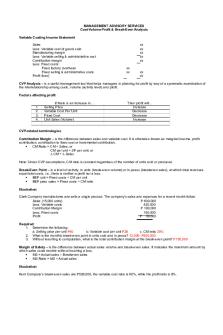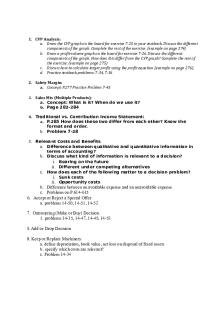Reviewer with Solution - CVP Analysis PDF

| Title | Reviewer with Solution - CVP Analysis |
|---|---|
| Course | BS Accountancy |
| Institution | Don Honorio Ventura Technological State University |
| Pages | 8 |
| File Size | 88.4 KB |
| File Type | |
| Total Downloads | 69 |
| Total Views | 223 |
Summary
Download Reviewer with Solution - CVP Analysis PDF
Description
Cost Volume Profit (CVP) Analysis Reviewer
1. Cubie Corporation has provided the following data concerning its only product: Selling price Current sales Break-even sales
$ 94 per unit 12,600 units 10,836 units
What is the margin of safety in dollars? Answer: $ 165,816 Solution: Margin of safety in dollars = Total sales - Break-even sales = (12,600 units × $94 per unit) - (10,836 units × $94 per unit) = $1,184,400 - $1,018,584 = $165,816
2. A manufacturer of tiling grout has supplied the following data: Kilograms produced and sold 480,000 Sales revenue $1,830,000 Variable manufacturing expense $942,000 Fixed manufacturing expense $230,000 Variable selling and administrative expense $358,000 Fixed selling and administrative expense $196,000 Net operating income $104,000 The company's contribution margin ratio is closest to: Answer: 29.0% Solution: Contribution margin = Sales - Variable expenses = $1,830,000 - ($942,000 + $358,000) = $1,830,000 - $1,300,000 = $530,000 CM ratio = Contribution margin ÷ Sales = $530,000 ÷ $1,830,000 = 0.2900
3. Moyas Corporation sells a single product for $10 per unit. Last year, the
company's sales revenue was $270,000 and its net operating income was $44,000. If fixed expenses totaled $91,000 for the year, the break-even point in unit sales was: Answer: 18,200 units Solution: Profit = (Sales - Variable expenses) - Fixed expenses $44,000 = ($270,000 - Variable expenses) - $91,000 Variable expenses = $270,000 - $91,000 - $44,000 = $135,000 CM ratio = Contribution margin ÷ Sales = ($270,000 - $135,000) ÷ $270,000 = 0.50 Dollar sales to break even = Fixed expenses ÷ CM ratio = $91,000 ÷ 0.50 = $182,000 Unit sales to break even = $182,000 ÷ $10 per unit = 18,200 units 4. Caraco Corporation has provided the following production and average cost data for two levels of monthly production volume. The company produces a single product. Production volume: 5,300 units 6,300 units Direct materials: $74.90 per unit $74.90 per unit Direct labor: $54.20 per unit $54.20 per unit Manufacturing overhead: $72.80 per unit $65.80 per unit The best estimate of the total cost to manufacture 5,700 units is closest to: Answer: $1,133,190 Solution: Total manufacturing overhead at 6,300 units = 6,300 units × $65.80 per unit = $414,540 Total manufacturing overhead at 5,300 units = 5,300 units × $72.80 per unit = $385,840 Variable manufacturing overhead per unit = Change in cost ÷ Change in activity = ($414,540 − $385,840) ÷ (6,300 units − 5,300 units)
= $28,700 ÷ 1,000 units = $28.70 per unit Fixed cost element of manufacturing overhead = Total cost − Variable cost element = $414,540 − (6,300 units × $28.70 per unit) = $414,540 − $180,810 = $233,730 Total variable manufacturing cost = Direct materials + Direct labor + Manufacturing overhead = $74.90 per unit + $54.20 per unit + $28.70 per unit = $157.80 per unit Total manufacturing cost = (Total variable manufacturing cost per unit × Total units manufactured) + Total fixed manufacturing cost = ($157.80 per unit × 5,700 units) + $233,730 = $899,460 + $233,730 = $1,133,190 5. Jorgenson Corporation has provided the following data for the first five months of the year: Machine Hours Lubrication Cost: January 245 $1,520 February 370 $1,655 March 420 $1,785 April 325 $1,595 May 385 $1,690 Using the least-squares regression method of analysis, the estimated variable lubrication cost per machine hour is closest to: Answer: $1.43 Solution: The regression line is Y = 1,150.18 + 1.4293X and the R2 is 0.9333. Therefore, the variable cost per machine hour for Lubrication is closest to $1.43. 6. Moyas Corporation sells a single product for $20 per unit. Last year, the company's sales revenue was $275,000 and its net operating income was
$72,000. If fixed expenses totaled $93,000 for the year, the break-even point in unit sales was: Answer: 7,750 units Solution: Profit = (Sales - Variable expenses) - Fixed expenses $72,000 = ($275,000 - Variable expenses) - $93,000 Variable expenses = $275,000 - $93,000 - $72,000 = $110,000 CM ratio = Contribution margin ÷ Sales = ($275,000 - $110,000) ÷ $275,000 = 0.60 Dollar sales to break even = Fixed expenses ÷ CM ratio = $93,000 ÷ 0.60 = $155,000 Unit sales to break even = $155,000 ÷ $20 per unit = 7,750 units 7. Decaprio Inc. produces and sells a single product. The company has provided its contribution format income statement for June. Sales (5,800 units) $ 232,000 Variable expenses 127,600 Contribution margin 104,400 Fixed expenses 87,100 Net operating income $17,300 If the company sells 6,000 units, its net operating income should be closest to: Answer: $20,900 Solution: Selling price per unit = Sales ÷ Quantity sold = $232,000 ÷ 5,800 units = $40 per unit Variable expenses per unit = Variable expenses ÷ Quantity sold = $127,600 ÷ 5,800 units = $22 per unit
Unit CM = Selling price per unit - Variable expenses per unit = $40 per unit - $22 per unit = $18 per unit Profit = (Unit CM × Q) - Fixed expenses = ($18 per unit × 6,000 units) - $87,100 = $108,000 - $87,100 = $20,900 8. Bendel Inc. has an operating leverage of 3.9. If the company's sales increase by 11%, its net operating income should increase by about: Answer: 42.9% Solution: Percentage change in net operating income = Degree of operating leverage × Percentage change in sales = 3.9 × 11% = 42.9% 9. Alpha Corporation reported the following data for its most recent year: sales, $630,000; variable expenses, $280,000; and fixed expenses, $280,000. The company's degree of operating leverage is closest to: Answer: 5.00 Solution: Contribution margin = Sales - Variable expenses = $630,000 - $280,000 = $350,000 Profit = Contribution margin - Fixed expenses = $350,000 - $280,000 = $70,000 Degree of operating leverage = Contribution margin ÷ Net operating income = $350,000 ÷ $70,000 = 5.00
10. Schister Systems uses the following data in its Cost-Volume-Profit analysis: Sales $340,000 Variable expenses 170,000
Contribution margin Fixed expenses Net operating income
170,000 108,000 $62,000
What is the total contribution margin if sales volume increases by 30%? Answer: $221,000 Solution: CM ratio = Contribution margin ÷ Sales = $170,000 ÷ $340,000 = 0.50 Contribution margin = CM ratio × Sales Contribution margin = 0.50 × (1.3 × $340,000) = $221,000 11. Serfass Corporation's contribution format income statement for July appears below: Sales $448,500 Variable expenses 224,250 Contribution margin 224,250 Fixed expenses 58,310 Net operating income $165,940 The degree of operating leverage is closest to: Answer: 1.35 Solution: Degree of operating leverage = Contribution margin ÷ Net operating income = $224,250 ÷ $165,940 = 1.35 12. A manufacturer of tiling grout has supplied the following data: Kilograms produced and sold 380,000 Sales revenue $1,870,000 Variable manufacturing expense $952,000 Fixed manufacturing expense $250,000 Variable selling and administrative expense $331,000 Fixed selling and administrative expense $216,000 Net operating income $121,000 The company's contribution margin ratio is closest to: Answer: 31.4%
Solution: Contribution margin = Sales - Variable expenses = $1,870,000 - ($952,000 + $331,000) = $1,870,000 - $1,283,000 = $587,000 CM ratio = Contribution margin ÷ Sales = $587,000 ÷ $1,870,000 = 0.3140 13. A cement manufacturer has supplied the following data: Tons of cement produced and sold 315,000 Sales revenue $1,019,000 Variable manufacturing expense $240,000 Fixed manufacturing expense $337,000 Variable selling and administrative expense $167,600 Fixed selling and administrative expense $101,000 Net operating income $173,400 The company's contribution margin ratio is closest to: Answer: 60.0% Solution: Contribution margin = Sales - Variable expenses = $1,019,000 - ($240,000 + $167,600) = $1,019,000 - $407,600 = $611,400 CM ratio = Contribution margin ÷ Sales = $611,400 ÷ $1,019,000 = 0.60 14. Derst Inc. sells a particular textbook for $21. Variable expenses are $11 per book. At the current volume of 40,000 books sold per year the company is just breaking even. Given these data, the annual fixed expenses associated with the textbook total: Answer: $400,000 Solution: Unit CM = Selling price per unit - Variable expenses per unit = $21 per book - $11 per book = $10 per book Unit sales to break even = Fixed expenses ÷ Unit CM 40,000 books = Fixed expenses ÷ $10 per book
Fixed expenses = 40,000 books × $10 per book = $400,000 15. Data concerning Bedwell Enterprises Corporation's single product appear below: Selling price per unit $ 200.00 Variable expenses per unit $ 95.50 Fixed expense per month $ 441,890 The unit sales to attain the company's monthly target profit of $27,000 is closest to: Answer: 4,487 Solution: Unit CM = Selling price per unit - Variable expenses per unit = $200.00 per unit - $95.50 per unit = $104.50 per unit Unit sales to attain a target profit = (Target profit + Fixed expenses) ÷ Unit CM = ($27,000 + $441,890) ÷ $104.50 per unit = $468,890 ÷ $104.50 per unit = 4,487 units...
Similar Free PDFs

MAS CVP Reviewer
- 26 Pages

CVP Analysis - CVP
- 9 Pages

Chapter 22 - CVP Analysis
- 52 Pages

CVP Analysis - MAS quiz
- 48 Pages

442821756 CVP Analysis docx
- 2 Pages

4.1 cvp2 - CVP Analysis
- 3 Pages

CVP Analysis - Lecture notes 9
- 2 Pages

Cost behaviour and CVP analysis
- 8 Pages

BUS 5110 w3p3 CVP analysis
- 5 Pages

FAR Reviewer with answers
- 27 Pages

CVP - Chapter 6 on CVP
- 2 Pages

Mas-fs Analysis reviewer
- 13 Pages
Popular Institutions
- Tinajero National High School - Annex
- Politeknik Caltex Riau
- Yokohama City University
- SGT University
- University of Al-Qadisiyah
- Divine Word College of Vigan
- Techniek College Rotterdam
- Universidade de Santiago
- Universiti Teknologi MARA Cawangan Johor Kampus Pasir Gudang
- Poltekkes Kemenkes Yogyakarta
- Baguio City National High School
- Colegio san marcos
- preparatoria uno
- Centro de Bachillerato Tecnológico Industrial y de Servicios No. 107
- Dalian Maritime University
- Quang Trung Secondary School
- Colegio Tecnológico en Informática
- Corporación Regional de Educación Superior
- Grupo CEDVA
- Dar Al Uloom University
- Centro de Estudios Preuniversitarios de la Universidad Nacional de Ingeniería
- 上智大学
- Aakash International School, Nuna Majara
- San Felipe Neri Catholic School
- Kang Chiao International School - New Taipei City
- Misamis Occidental National High School
- Institución Educativa Escuela Normal Juan Ladrilleros
- Kolehiyo ng Pantukan
- Batanes State College
- Instituto Continental
- Sekolah Menengah Kejuruan Kesehatan Kaltara (Tarakan)
- Colegio de La Inmaculada Concepcion - Cebu



